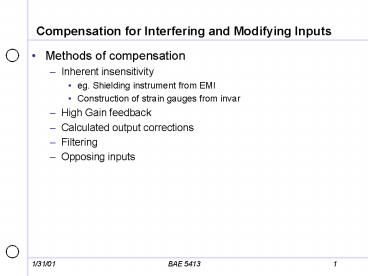Compensation for Interfering and Modifying Inputs PowerPoint PPT Presentation
1 / 11
Title: Compensation for Interfering and Modifying Inputs
1
Compensation for Interfering and Modifying Inputs
- Methods of compensation
- Inherent insensitivity
- eg. Shielding instrument from EMI
- Construction of strain gauges from invar
- High Gain feedback
- Calculated output corrections
- Filtering
- Opposing inputs
2
Method of inherent insensitivity
- Minimize Fi, Fmi, Fmd
- Selectivity - ability to of an instrument to
select the input of interest and reject
interference signals
3
Method of high gain feedback
- System with modifying input
4
Method of high gain feedback
- Feedback loop added
- Kfb gtgt1
- O is no longer a function of Fd(Im)
5
Method of calculated output correction
- Computer based systems allow correction to be
made easily - Requires that Ii be measured also
6
Method of Opposing Inputs
- Input information is used in some manner to form
a correcting signal within the instrument
7
Method of filtering
- Removes interfering signal
- Frequency of desired signal must be different
from frequency of interference
8
Reporting Instrument Error
- NIST 1297
- Standardizes the reporting of uncertainty
- Coordinated with CIPM/ISO
- Based on representing each component of
uncertainty (ui) in a measurement by an estimated
standard deviation associated with that
component. ui standard uncertainty - Divides types of uncertainty into two categories
- Type A - can be evaluated directly as a standard
deviation - Type B - must be estimated in non-statistical
fashion, but is expressed as a standard deviation - Assumes a correction factor is applied to remove
systematic error (bias is removed by calibration) - Defines combined uncertainty (uc) as the RMS of
the component uncertainties
9
NIST 1297 -cont-
- Note
- and
- Defines expanded uncertainty, U, as the range
within which the value of the measurand(Y) can
confidently be expected to lie. And expanded
uncertainty can be calculated as a product of
coverage factor (k), and combined uncertainty
(uc) - Y- measurand, y - measurement result
10
NIST 1297 -cont-
- Recommends use of a coverage factor of 2 (This is
equivalent to ?2 standard deviations or 95 if
normal) or an explanation why.
11
Traceability of measurand and uncertainty
- A traceable measurand is not needed for
determination of uncertainty. - Correction of systematic error or bias is assumed
- Standard deviation of y given a single Y allows
u(y) to be determined

